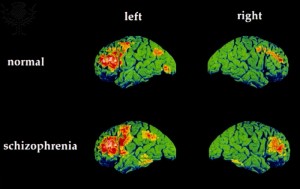Schizophrenia is a mental illness that effects almost 24 million people throughout the world. It is not possible to diagnose this illness with a test, instead one must go through a mental evaluation. Patients diagnosed with schizophrenia are usually prescribed anti-psychotics and therapies. These medications are often ineffective causing constant development of new drug therapies. Many are also trying to find the cause of this illness.
Schizophrenic patients are found to have lesser amounts of a protein called beclin-1. This protein is found in the part of the brain that retains memory and learning. Autophagy, clearing of unimportant cell components, is made possible by these proteins. If autophagy is not successful brain cells can die. Scientists are continuing research to find a drug with increased levels of beclin-1 to restore balance in the brain.
Researchers are looking into the possibility of a blood test to diagnose schizophrenia. A gene called the major histocompatability complex (MHC) is a DNA chunk that carries information to identify invaders. This gene is part of a protein that snips connections in nerves. Geneticist Steven McCarroll from Harvard University and the Broad Institute has looked at genetic material of 60,000 people with and without schizophrenia. McCarroll has found that different types of a gene in MHC elevates the risk of schizophrenia.
Schizophrenia has effected many people all over the world. The possibility of finding a test for this illness would help millions by using these instead of a psychoanalysis. Also, improved drug therapies could assist those suffering from this illness. Pinpointing a gene causing schizophrenia could assist in diagnosis, treatment, and eventually prevention.
Do you think that it is possible to cure schizophrenia with this evidence?
Will someone find a test for schizophrenia?
Are we closer to finding a more effective drug treatment?

